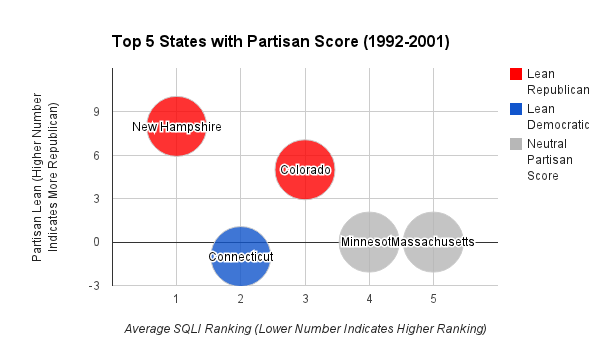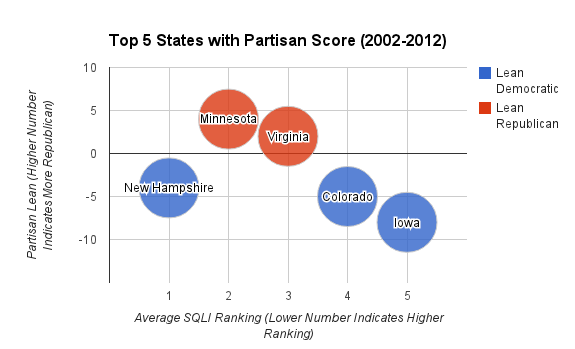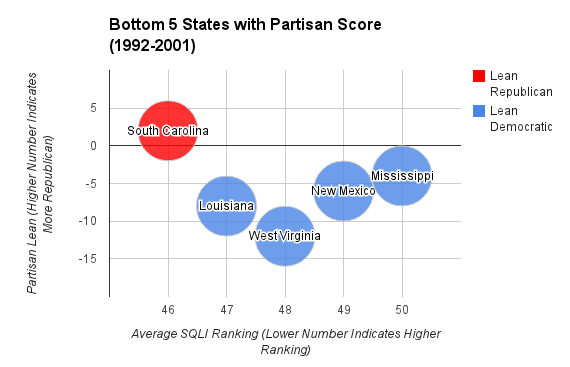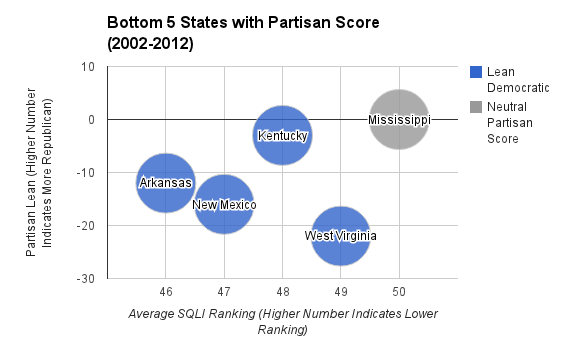It’s the 12 Days of Ballotpedia! Your gift powers the trusted, unbiased information voters need heading into 2026. Donate now!
Ballotpedia:Who Runs the States, Part Three, Trends and correlations
Praise or blame is extended to political parties for the economic, educational, health and other quality of life outcomes that result from the policies those parties enact into law. To better understand which political party enjoys power in each of the states, Ballotpedia has analyzed state government control from 1992-2013 using the concept of a "partisan trifecta." A partisan trifecta is defined as when a state's governorship and legislative chambers are controlled by the same political party.
The two major political parties claim that their policies will lead to better outcomes. What does the data show?
At Ballotpedia, we explored these issues in a three-part study, Who Runs the States.
This page contains the section of Part Three pertaining to the Trends and correlations.
Trends and correlations
After generating coded values for the partisanship and quality of life indices, we performed regression analysis to compare the two metrics to identify trends and correlations. In this section, we present some of the interesting trends found in our tabulations and basic regression analyses. Although we used regression models that may suggest causality in other situations, these basic comparisons between indexes and rankings through regression models were primarily designed to indicate correlations and potential areas for further research.[1] This analysis indicates situations where states performed better when, or after, certain combinations of party governments were in power.
We created a measure called “partisan lean,” referring to a coding system by which we defined the level of partisanship for a given state. Trendline analysis showed a slightly positive trend toward better SQLI with Republican leaning governments. In other words, more Republican-leaning states are in the top 25 of SQLI than Democratic-leaning states. Additionally, there were more Democratic states in the bottom 25 than Republican states. This data shows a positive trend toward Republican governments leading toward higher SQLI rankings. For more details and regression results, see Appendix D: Key Values for Fifty State Regressions.
In addition to the national findings, there are some individual state results worth noting. For example, a time-lagged panel data regression model of Georgia shows that the state has performed better two years after being under more Republican control. For more information and a complete list of state-by-state results, please see Appendix C: Key Values for Individual State Regressions.
Comparing the performance of top 5 and bottom 5 states
During the first half of the study period (1992-2001), the five states that performed the best in SQLI were New Hampshire, Connecticut, Colorado, Minnesota and Massachusetts. These states had an average partisan lean of 2.4, indicating that they were slightly more Republican. Among the states in this group, 86 percent were divided government and 14 percent were trifectas. These states included seven trifectas, all of which were Republican.
During the second half of the study period (2002-2012), the top five performing SQLI states were New Hampshire, Minnesota, Virginia, Colorado and Iowa. Those states had an average partisan lean of -2.2, indicating that they were slightly more Democratic. Among the states of this group, 69.1 percent had divided government and 30.9 percent had trifectas. Of the 17 trifectas, 12 were Democratic and 5 were Republican.
The states that were in the bottom five performing SQLI states during the first half of the study period were South Carolina]], Louisiana, West Virginia, New Mexico and Mississippi. Those states had an average partisan lean of -5.6, indicating that they leaned Democratic. Among the states in this group, 70 percent had divided government and 30 percent had party trifectas. Of the 15 trifectas, all 15 were Democratic.
The bottom five performing states during the second half of the study period were Arkansas]], New Mexico, Kentucky, West Virginia, and Mississippi. Those states had an average partisan lean of -10.6 during the latter half of the study period, indicating they leaned Democratic substantially. Among states finishing in the bottom five of the SQLI during the second half of the study, 49.1 percent of those states were divided government and 50.9 were trifectas. Of the 28 trifectas, 27 were Democratic and 1 was Republican.
Comparing trifectas over time
Next we considered states that had a trifecta of party control over time. In the first half of the study, trifectas finished in the top-10 in rankings 10.6 percent of the time, and in the bottom-10 rankings 18.8 percent of the time. Only 22 of the 208 states with a trifecta from 1992-2001 finished in the top-10 for that year. Thirty-nine of the 208 finished in the bottom-10.
In the second half of the study, trifectas finished in the top-10 in rankings 17 percent of the time, and in the bottom-10 rankings 20 percent of the time. Forty-five of the 265 states with a trifecta from 2002-2012 finished in the top-10 for that year. Fifty-three of the 265 finished in the bottom-10.
These data show that in both periods a state with a trifecta was more likely to rank in the bottom-10 than the top-10. However, the gap decreased significantly from the first to second periods, with a jump in the percentage ranking in the top-10. Some of this is accounted for by states with a long record of trifectas that were able to break into the top-10 in the second period, such as Utah and North Dakota. Another factor is states like Colorado, which ranked in the top-10 throughout the study period but has seen a rise in trifectas in recent years. There is no clear example of a state with mostly divided government in the first period moving into the top-10 after trifectas in the second period.
Underperforming single-party states
We reviewed the data to find those states with both poor performance on the SQLI and lengthy single-party control. In which states should residents be disappointed in the results of single-party control? Two states stand in the data out as examples of underperforming states whose governments have been dominated by a single party in recent decades.
In West Virginia, Democrats held trifectas for 18 of the 22 years in the study period. During the other four years, Democrats still had control of the state legislature. West Virginia tied with Maryland as the most Democratic state with a score of -36 on our aggregate partisanship rankings. The state’s overall SQLI ranking was 49.
In South Carolina, Republicans held trifectas for 11 of the 22 years and had control of the governorship for 18 of the 22 years. South Carolina was the seventh most Republican state with a score of 24 on our aggregate partisanship rankings. The state’s overall SQLI ranking was 45.
See also
- Ballotpedia:Who runs the states
- Ballotpedia:Who Runs the States, Part One: State Partisanship
- Ballotpedia:Who Runs the States, Part Two: State Quality of life Index (SQLI)
- Ballotpedia:Who Runs the States, Part Three: Overlaying State Partisanship and State Quality of Life (SQLI)
- Part 1 Full report PDF
- Part 2 Full report PDF
- Part 3 Full report PDF
- State government trifectas
External links
- ↑ These analyses should not be taken as indicating a causal link between party control of the levers of power in a state government, and that state's performance.







